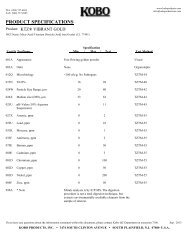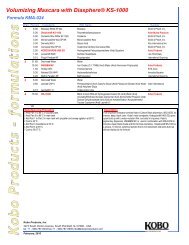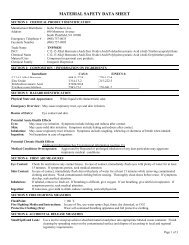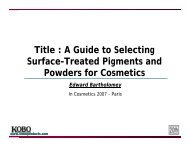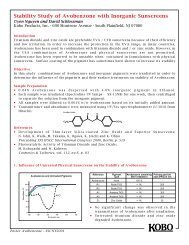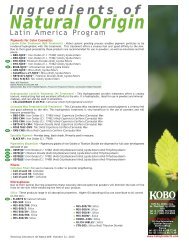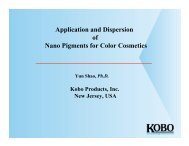«Non-Nano» Zinc Oxide - Kobo Products Inc.
«Non-Nano» Zinc Oxide - Kobo Products Inc.
«Non-Nano» Zinc Oxide - Kobo Products Inc.
Create successful ePaper yourself
Turn your PDF publications into a flip-book with our unique Google optimized e-Paper software.
«Non-Nano»<br />
<strong>Zinc</strong> <strong>Oxide</strong><br />
Pascal Delrieu, Yun Shao, and David Schlossman<br />
<strong>Kobo</strong> <strong>Products</strong>, <strong>Inc</strong>.<br />
SCC - Annual Scientific Meeting - December 2009<br />
www.koboproducts.com
Introduction<br />
• In the past years, arguments have been made by consumer<br />
groups and environmental organizations about safety of<br />
nanoparticles.<br />
• Accordingly, international regulatory agencies continue to<br />
move towards global «nano» regulation (ex : Amended<br />
European Union Cosmetic Directive in March 2009).<br />
• The control of TiO 2 and ZnO particle size has been known<br />
since the 1980’s to be a key element in obtaining optimum UV<br />
attenuation and a transparency acceptable for cosmetic use ;<br />
because it has a lower refractive index than titanium dioxide,<br />
zinc oxide was considered a more suitable choice as a nonnano<br />
sunscreen pigment.<br />
www.koboproducts.com
EU Directive - Nanoparticle Definition<br />
An insoluble or bio-resistant and intentionally manufactured<br />
material with one or more external dimensions, or an internal<br />
structure, on the scale from 1 to 100 nm<br />
Definition of Nanomaterials - Amended European Union Cosmetic Directive -<br />
March 2009<br />
The purpose of this study was :<br />
• to understand particle size measurement methods and the<br />
significance of their results<br />
• to apply these results to the development of non-nano ZnO<br />
sunscreen pigments<br />
www.koboproducts.com
Particle Size<br />
• The primary particle size (pps) is the size<br />
of the crystals obtained during the<br />
production process.<br />
• However, when supplied as a powder,<br />
particles are agglomerated (agglomerates<br />
typically in excess of 1 micron).<br />
Agglomerate<br />
PPS<br />
• To be used as a sunscreen, the size of these<br />
agglomerates have to be reduced : the size<br />
of the resulting aggregates affects the UV<br />
attenuation and transparency.<br />
Size<br />
reduction<br />
Aggregates<br />
Internal structure <br />
www.koboproducts.com
Significance of Size Measurement<br />
Mean / Median Particle Size<br />
Attenuation of a specific<br />
UV light range<br />
Tail/small sizes<br />
Nanomaterial regulations<br />
Tail/large sizes<br />
Contribute to<br />
skin whitening<br />
www.koboproducts.com
Size Measurement Methods<br />
• Electron Microscopy (SEM or TEM) + Image Analysis<br />
• Measure a global characteristics of a suspension (Light<br />
scattering, Brownian movement, sound attenuation, …) +<br />
Convertion to size and distribution<br />
• Results can be averaged using different methods : Length (or<br />
Number Mean) or Volume Mean ; Volume mean is generally<br />
preferred : AAPS Journal 2004:6(3) article 20<br />
d i<br />
Number mean = D[1,0] = <br />
n<br />
d i<br />
4<br />
Volume mean = D[4,3] = <br />
d i<br />
3<br />
www.koboproducts.com
Electron Microscopy & Image Analysis<br />
Transmission electron microscopy (TEM)<br />
Length / width of each visible<br />
particle is measured (manual /<br />
computer).<br />
Measures Primary Particle Size<br />
Scanning electron microscopy (SEM)<br />
Limitations and biases :<br />
• Sampling : reliable description of the<br />
size distribution implies a large<br />
number of particles (ISO 13322-1).<br />
• Geometry : analysis of 3-dimensional<br />
objects on a 2-dimensions image.<br />
• Ease of use : not a technique that can<br />
be routinely used for size<br />
measurements.<br />
www.koboproducts.com
Laser Diffraction<br />
• Laser Diffraction / Light Scattering<br />
instruments analyze the light scattering<br />
properties of a suspension of particles and<br />
convert it into particle size/distribution.<br />
• Gives a reliable description of the size<br />
distribution<br />
• Measures the size of aggregates in a solvent : cannot be used for<br />
measuring Primary Particle Size<br />
• Quick, easy to use & repeatable method<br />
• Depending on their polarity, some solvents can disperse inorganic<br />
UV filters efficiently, when others will promote agglomeration :<br />
size measurements need to be made in different solvents (IPA &<br />
Hexane)<br />
www.koboproducts.com
Possible Answers to Nano Regulations<br />
• Use current «nano» inorganic filters and mention “contains<br />
nanotechnology” on the label<br />
• Interpret the EU definition narrowly as Primary Particle Size<br />
(Electron Microscopy & Image Analysis)<br />
• Interpret the EU definition broadly as Aggregate Particle Size<br />
(Laser Diffraction)<br />
• Other possibilities (complex particles)<br />
www.koboproducts.com
Non-nano ZnO<br />
(Primary Particle Size greater than 100 nm)<br />
www.koboproducts.com
Large Size ZnO (USP3)<br />
Size = (long axis + short axis)/ 2<br />
Mean size : 170 nm<br />
% below 100 nm : 20 %<br />
Size = short axis<br />
Mean size : 126 nm<br />
% below 100 nm : 42 %<br />
205 particles measured<br />
200 nm<br />
www.koboproducts.com
ZnO-C - Non-Nano <strong>Zinc</strong> <strong>Oxide</strong><br />
100 nm<br />
Data Courtesy of Sumitomo Osaka Cement<br />
www.koboproducts.com
ZnO-C - Particle size distribution (1)<br />
Frequency(%)<br />
Total(%)<br />
Measurement made on 5 SEM pictures<br />
representing about 600 particles<br />
Distribution calculated for 2-axis<br />
mean diameter<br />
www.koboproducts.com
ZnO-C - Particle size distribution (2)<br />
Measurement<br />
Cumulative Diameter<br />
D10%<br />
(nm)<br />
D50%<br />
(nm)<br />
D90%<br />
(nm)<br />
< 100nm<br />
(%)<br />
Mean Diameter<br />
(nm)<br />
Long-axis 189 343 651 0.3 396<br />
Short-axis 131 201 312 2.2 214<br />
Equivalent circular diameter* 150 232 365 0.9 249<br />
2-axis mean diameter 166 260 444 0.4 297<br />
Calculated using Mac-View (Particle Size Distribution Analysis Software) on 606 particles<br />
* projected area diameter<br />
www.koboproducts.com
Surface Treated ZnO-C - Distribution (1)<br />
Triethoxy Caprylylsilane - treated ZnO-C<br />
Frequency(%)<br />
Total(%)<br />
Measurement made on 7 SEM pictures<br />
representing about 600 particles<br />
Distribution calculated for 2-axis<br />
mean diameter<br />
www.koboproducts.com
Surface Treated ZnO-C - Distribution (2)<br />
Triethoxy Caprylylsilane - treated ZnO-C<br />
Measurement<br />
Cumulative Diameter<br />
D10%<br />
(nm)<br />
D50%<br />
(nm)<br />
D90%<br />
(nm)<br />
< 100nm<br />
(%)<br />
Mean Diameter<br />
(nm)<br />
Long-axis 138 223 383 0 404<br />
Short-axis 110 150 236 0 239<br />
Equivalent circular diameter* 127 182 281 0 266<br />
2-axis mean diameter 135 196 311 0 317<br />
Calculated using Mac-View (Particle Size Distribution Analysis Software) on 678 particles<br />
* projected area diameter<br />
www.koboproducts.com
ZnO-C - Efficacy (W/O emulsion)<br />
In Vivo<br />
ZnO-C<br />
Ultrafine<br />
ZnO*<br />
SPF 12.1 ~15 - 20<br />
PFA 5.52 ~ 7.5 - 8<br />
In Vitro<br />
SPF 5.68 NA<br />
UVA ratio 0.88 ~ 0.6 -0.85<br />
Critical wavelength<br />
(nm)<br />
381 ~ 370 - 375<br />
• In-vivo test made with 3 panelists<br />
• 15 % ZnO<br />
* typical range<br />
www.koboproducts.com
ZnO-C - Transparency<br />
2 mg/cm 2 on tanned skin<br />
Ultrafine ZnO<br />
(60nm primary particle size)<br />
Non nano ZnO-C<br />
www.koboproducts.com
Non-nano ZnO<br />
(Particle Size in Dispersion greater than 100 nm)<br />
www.koboproducts.com
Surface Treatments Promoting Large Aggregates<br />
• ZnO are often surface treated to be hydrophobic for good wetting<br />
in a formula and pleasant skin feel.<br />
• We have evaluated several hydrophobic treatments for their<br />
capacity to promote larger aggregates<br />
• Jojoba ester treatment is able to cause the primary particles to<br />
form aggregates and meet the non-nano criteria<br />
Coating process<br />
Aggregates harder to dissociate<br />
www.koboproducts.com
Effect of Jojoba Esters Coating on Size<br />
ZnO (20nm Primary Particle Size) coated with 5% Jojoba Ester<br />
Powder dispersed in solvents<br />
IPA<br />
Hexane<br />
Percent of particles < 100nm<br />
• in IPA : 0%<br />
• in Hexane : 0%<br />
www.koboproducts.com
Performance of Non-Nano ZnO<br />
Formula Z-1 Z-2<br />
ZnO 20 nm Non-nano<br />
PS in disp. (nm) some < 100 nm all > 100<br />
SPF 17.4 22.4<br />
SPF/Active% 1.16 1.49<br />
PFA 8.17 8.67<br />
PFA/Active% 0.54 0.57<br />
• 15% ZnO in W/O sun lotion<br />
• in-vivo test, 3 panelists<br />
www.koboproducts.com
Jojoba Ester-coated ZnO - Transparency<br />
2 mg/cm 2 on tanned skin<br />
Nano ZnO<br />
Non nano ZnO<br />
www.koboproducts.com
Non-nano ZnO<br />
(Complex Particle : Small ZnO Particles trapped<br />
within a Large Polymer Bead)<br />
www.koboproducts.com
Complex ZnO-PMMA Particle<br />
• Small (20nm PPS) ZnO particles entrapped within<br />
a large (650nm) PMMA bead<br />
• 50% ZnO content<br />
ZnO<br />
20nm PPS<br />
PMMA Particle<br />
www.koboproducts.com
Particle Size Distribution<br />
Image Analysis of 2 SEM<br />
Pictures (171 particles)<br />
frequency(%)<br />
total(%)<br />
Size Measurement of<br />
D5 Dispersion<br />
(Laser Diffraction)<br />
www.koboproducts.com
Particle Size<br />
Measurement<br />
Cumulative Diameter<br />
D10%<br />
(nm)<br />
D50%<br />
(nm)<br />
D90%<br />
(nm)<br />
< 100nm<br />
(%)<br />
Mean Diameter<br />
(nm)<br />
Long-axis 422 653 858 0.02 649<br />
Short-axis 402 628 837 0.17 617<br />
Equivalent circular diameter* 411 634 832 0.14 624<br />
2-axis mean diameter 426 661 898 0.12 664<br />
Dispersion (LD) 476 639 831 0 647<br />
www.koboproducts.com
Summary - Size Measurement<br />
• Concerns over safety of nano materials and changes in<br />
regulations have led to the need of inorganic UV filters for<br />
which a 'Non-Nano' label claim can be made.<br />
• Electron Microscopy coupled with Image Analysis is suitable for<br />
measurement of Primary Particle Size.<br />
• Laser Diffraction is suitable for the measurement of the<br />
particle size of aggregates in suspension.<br />
• Each techniques has limitations and biases, including<br />
calculation methods and sample preparation.<br />
www.koboproducts.com
Summary - Non Nano ZnO<br />
• ZnO-C, because of its relatively narrow distribution, can be<br />
used in sunscreens with great benefits (UVA). The percentage<br />
of primary particles bellow 100nm is very limited.<br />
• A Jojoba Esters treatment can be used to make large, 'Non-<br />
Nano' aggregates of nanoparticles, when measured with Laser<br />
Diffraction.<br />
• A submicron PMMA bead, containing nano ZnO particles, can<br />
also be used.<br />
• All the above products may meet the definition of non nano,<br />
depending on the interpretation of the new regulations.<br />
www.koboproducts.com
Acknowledgement<br />
• Sumitomo Osaka Cement<br />
• Neringa Kontrimiene<br />
• Carl Orr<br />
• Ed Bartholomey<br />
www.koboproducts.com



